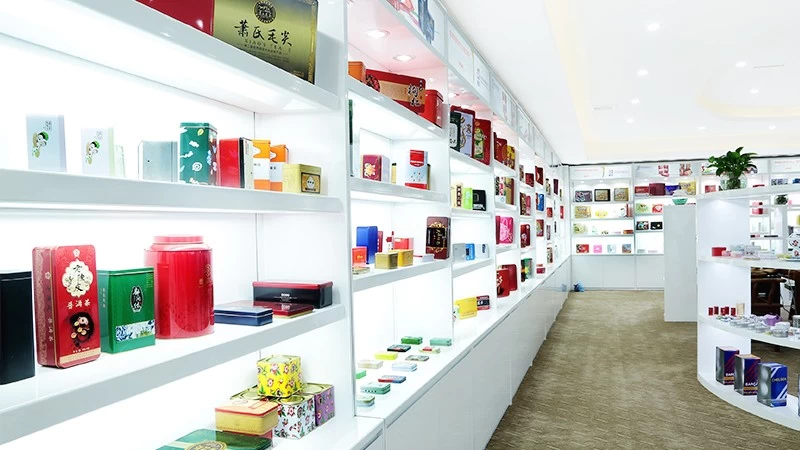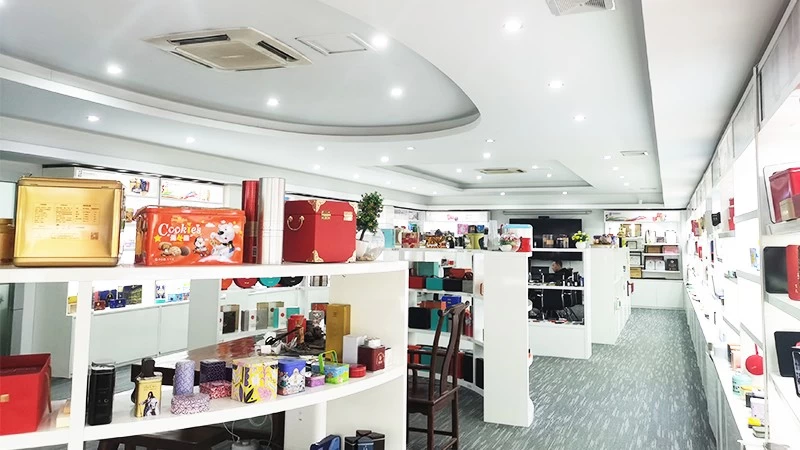This year we carefully created a PU leather handle coffee tin box for the coffee brand. The size is 185x136x85mm. It is made of food-grade tinplate and the material thickness is 0.23mm.
This year, Cosmetics Brands joined hands with our professional tin box manufacturer to create a cosmetic tin box with handle that combines beauty and practicality. This is not only a container for beautiful things, but also an ode to a refined attitude towards life.
The Xmas detachable candy balls is made of tinplate, the iron box is strong and durable. It is not easy to open directly, you can easily open the hemisphere without the string by pulling the string. The Christmas ball can be used as a candy jar, and the candy ball has enough space for candies, chocolates, trinkets, and small things. At the same time, its lovely shape and hanging ribbon are also perfect for Christmas tree decoration
Material and safety Food-grade tinplate material, light and durable, drop-proof and rust-proof, in line with food safety standards. The interior adopts environmentally friendly coating, no odor, and can directly contact food. Customized printing Full-surface high-definition printing: supports single-sided/double-sided customization of corporate logos, patterns, slogans or art designs. Process selection: silk screen printing, hot stamping, UV embossing and other processes are optional to enhance the brand texture. Applicable scenarios: employee benefits, event gifts, promotional gifts, campus customization, etc.
Our round tin cookie box is an elegant and practical packaging solution designed to keep your cookies fresh and beautifully presented. Made from high-quality tinplate, it offers excellent durability and protection against moisture and breakage. The smooth, classic round shape adds a touch of sophistication, making it perfect for gifts, festive treats, or everyday storage. With customizable designs, sizes, and finishes, this tin box not only preserves the delicious taste of your cookies but also enhances your brand’s image with eye-catching, reusable packaging.
This heart-shaped tin box is made from food-grade material, making it safe for storing a variety of candies and gifts. Perfect for the holiday season, this charming tin adds both function and holiday cheer to any celebration.
These discreet low profile rectangle tins feature a clean & fresh style that will remain modern for many uses to come. Our lightweight durable containers are made from high-quality material. Reliable hinge & seal for a perfect closure every time. General household organizing, crafts, homemade packaging, store spices, tea leaves, coffee beans, chocolates, mints, creams, balms, gels, jewelry, beads, sequins, recipe cards, arts, medicines, pills, lip balm, cosmetics, gifts, party favors, Double button locking hinged lid that offers great child resistant packaging.
Designed for exquisite chocolates, our custom food-grade rectangular chocolate tinplate boxes provide safe, beautiful and highly flexible packaging solutions. This packaging box is strictly made of high-quality tinplate materials that meet food contact safety standards (such as FDA/GB) to ensure that the contents are pure and uncontaminated. The classic rectangular design is not only simple and elegant in appearance and full of modernity, but also can efficiently utilize space, making it easy to stack, transport and retail display. The core advantage lies in its deep customization service - you can freely choose the box size, color (internal and external coating), pattern printing (high-definition color printing, hot stamping/silver, etc.), and lining material (such as food-grade white cardboard tray, PET blister tray, flannel, etc.), perfectly carrying and enhancing the value and protection of your brand chocolate. The sturdy iron box structure provides excellent sealing and moisture-proof performance, effectively extending the freshness and shelf life of chocolate, and is an ideal packaging choice for high-end chocolate brands, gift markets and baking industries.
As an environmentally friendly material, the cost of tin box packaging cannot be simply generalized compared with traditional materials. The cost of tin box packaging is affected by many factors. First, the price fluctuations of tinplate raw materials will affect the cost of tin boxes. Secondly, the thickness, specifications, and processing technology of the tin box will have an impact on the cost. Generally speaking, when customizing, choose tin box manufacturers in different regions. The thickness of the tin box is different, and the required cost is different. The commonly used iron sheet thickness is between 0.23mm and 0.38mm. Tin boxes come in various shapes, such as round, special-shaped, square, etc. The thickness of different shapes is different, the amount of tinplate raw materials required is different, and the cost also varies. Moreover, tin boxes with simple production process requirements and uncomplicated production are relatively cheap. For example, round tin boxes are usually easier to make than square tin boxes, and the cost is relatively lower.

However, from a long-term and comprehensive perspective, tin box packaging has the advantages of being recyclable, low-pollution, and resource-saving. Although the packaging cost of tin boxes may be slightly higher than some traditional plastic packaging in the initial procurement stage, tin boxes can be recycled, which can reduce the waste of packaging resources and reduce the impact on the environment. With the enhancement of environmental awareness and the improvement of resource recycling systems, the comprehensive cost of tin box packaging throughout its life cycle may not be higher than that of traditional materials. Therefore, it cannot be simply determined that the cost of tin box packaging made of environmentally friendly materials must be higher than that of traditional materials. It is necessary to consider a variety of factors and long-term benefits.
The impact of tinplate raw material prices on tin box costs
As the main raw material of tin boxes, the price fluctuation of tinplate has an important impact on the cost of tin boxes. The price of tinplate raw materials directly determines the cost of tin box raw materials. In recent years, the price of tinplate has been constrained by many factors, such as market supply and demand, changes in upstream raw material prices, and international trade situations. When the price of tinplate rises, the cost of tin boxes will increase accordingly; conversely, when the price of tinplate falls, the cost of tin boxes will also decrease. For example, in certain periods, due to the tight supply of tinplate and soaring prices, tin box manufacturers face greater cost pressure and have to adjust their production strategies or increase product prices.
How does the thickness and size of tin boxes affect costs
The thickness and size of tin boxes are key factors affecting their costs. Generally speaking, the thicker the tin box, the more tinplate raw materials are required, and the higher the cost. Tin boxes of different sizes, such as round, square, and special-shaped, consume different amounts of materials during the production process. Larger tin boxes usually require more tinplate, and the process difficulty may also increase, leading to higher costs. Taking round tin boxes and square tin boxes as examples, under the same thickness, square tin boxes may cost slightly more than round tin boxes due to relatively complex processes such as corner processing. In addition, some tin boxes of special sizes, such as super-large or super-small tin boxes, will also significantly increase costs due to the difficulty of production and high requirements for molds and equipment.
The relationship between tin box shape and cost
The shape of the tin box has a significant impact on the cost. Common tin box shapes include round, square, and special-shaped. The round tin box is relatively simple to make because of its regular shape, easy to stamp and form, and the cost is usually low. The square iron box requires more processes and technologies to process the corners, so the cost will be slightly higher than the round tin box. However, special-shaped tin boxes, such as heart-shaped and polygonal, are the most expensive because of their complex shapes, high stamping difficulties, high requirements for molds, and easy losses during the production process. For example, making a heart-shaped tin box may require a specially customized mold, and more precise control is required during the stamping process to avoid material waste and product defects, which will increase costs.
The effect of tin box production process on cost
The production process of tin boxes is complex and diverse, including printing, stamping, assembly, packaging and other links. Different production processes have different effects on costs. Advanced production processes can improve production efficiency and product quality, but often require more equipment and technology, which increases costs. For example, the use of automated printing equipment can improve the accuracy and speed of printing, but the purchase and maintenance costs of the equipment are high. Although the traditional manual process is relatively low in cost, it is inefficient and difficult to ensure product consistency. In addition, some special processes, such as embossing and laser, can increase the beauty and added value of tin boxes, but will also greatly increase the cost.

Comparison of long-term comprehensive costs of tin box packaging and traditional materials
From the perspective of long-term comprehensive costs, tin box packaging has certain advantages over traditional materials such as plastics and paper. Although the initial production cost of tin box packaging may be high, it is reusable and easy to recycle. Although the initial cost of plastic packaging is low, it is difficult to degrade, causing serious pollution to the environment, and the cost of post-processing is high. Although paper packaging is recyclable, it is not as good as iron boxes in terms of moisture-proof and waterproof properties, and is easily damaged after repeated use. For example, an iron box can be made into a new tin box again after recycling, while plastic packaging often deteriorates in quality during the recycling process and is difficult to be used again for high-quality packaging. In addition, tin box packaging can better protect the product, reduce product losses during transportation and storage, and reduce costs overall.
Conclusion: Overall, the cost of tin box packaging made of environmentally friendly materials is not necessarily higher than that of traditional materials. Although the initial production stage may require a relatively high cost for customized tin box packaging, its comprehensive cost is competitive in terms of long-term use, recycling, and product protection. Moreover, with the continuous enhancement of environmental awareness and the development of related technologies, the cost of tin box packaging is expected to be further reduced, making it more advantageous in the market.